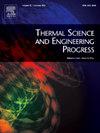研究了洛伦兹力对多针圆柱结构中电晕放电产生的电流体动力流的影响
IF 5.1
3区 工程技术
Q2 ENERGY & FUELS
引用次数: 0
摘要
本研究研究了在大气条件下,使用电磁辅助系统在多针到气缸配置中提高电流体动力(EHD)流速。开发了一种测量气流速度的实验装置,包括电晕放电发射器、螺线管和精密仪器。利用析因分析评估了射极电压、螺线管电压(磁场强度)和针筒距离对气流速度的影响。研究结果强调了螺线管磁场通过洛伦兹力提高EHD流速的作用。在最大射极电压为20.63 kV,射极距离为18 mm,电磁阀电压为30 V的条件下,最大风速为2.10 m/s。与零螺线管电压相比,施加洛伦兹力可使不同的发射极电压和距离使空气速度提高4.9 - 56.7%。当螺线管电压为15 V时,增加幅度为4.9%至35.5%,当螺线管电压为30 V时,增加幅度为8%至56.7%。15v和30v的平均速度分别提高了18.63%和39.94%。在固定的发射极电压和距离下,增加螺线管电压会增强速度,表明洛伦兹力对离子加速和动量传递到空气分子的影响。帕累托分析证实,电磁阀和发射极电压都对流量增强有显著贡献。这些结果强调了洛伦兹力在增强EHD流动中的重要性,并表明优化螺线管电压可以提高基于EHD的技术在热交换器、冷却系统和微流体装置等应用中的性能。本文章由计算机程序翻译,如有差异,请以英文原文为准。

Investigating the effects of Lorentz forces on electrohydrodynamic flow generated by corona discharge in a multi needle-to-cylinder configuration
This study investigates the enhancement of electrohydrodynamic (EHD) flow velocity in a multi needle-to-cylinder configuration using an electromagnetically assisted system under atmospheric conditions. An experimental setup was developed to measure airflow velocity, incorporating a corona discharge emitter, solenoid, and precise instrumentation. The impact of emitter voltage, solenoid voltage (magnetic field strength), and needle-to-cylinder distance on airflow velocity was evaluated using factorial analysis. The results highlight the role of the solenoid-generated magnetic field in enhancing EHD flow velocity via Lorentz forces. The maximum air velocity of 2.10 m/s was achieved with a maximum emitter voltage of 20.63 kV, emitter distance of 18 mm, and solenoid voltage of 30 V. Applying Lorentz force increased air speed by 4.9–56.7 % for different emitter voltages and distances compared to zero solenoid voltage. With a solenoid voltage of 15 V, the increase ranged from 4.9 % to 35.5 %, and with 30 V, it ranged from 8 % to 56.7 %. The average velocity increase was 18.63 % for 15 V and 39.94 % for 30 V. At a fixed emitter voltage and distance, increasing the solenoid voltage enhanced velocity, demonstrating the influence of Lorentz forces on ion acceleration and momentum transfer to air molecules. Pareto analysis confirmed that both solenoid and emitter voltages significantly contribute to flow enhancement. These results highlight the importance of Lorentz forces in enhancing EHD flow and suggest that optimizing solenoid voltage could improve the performance of EHD-based technologies in applications like heat exchangers, cooling systems, and microfluidic devices.
求助全文
通过发布文献求助,成功后即可免费获取论文全文。
去求助
来源期刊

Thermal Science and Engineering Progress
Chemical Engineering-Fluid Flow and Transfer Processes
CiteScore
7.20
自引率
10.40%
发文量
327
审稿时长
41 days
期刊介绍:
Thermal Science and Engineering Progress (TSEP) publishes original, high-quality research articles that span activities ranging from fundamental scientific research and discussion of the more controversial thermodynamic theories, to developments in thermal engineering that are in many instances examples of the way scientists and engineers are addressing the challenges facing a growing population – smart cities and global warming – maximising thermodynamic efficiencies and minimising all heat losses. It is intended that these will be of current relevance and interest to industry, academia and other practitioners. It is evident that many specialised journals in thermal and, to some extent, in fluid disciplines tend to focus on topics that can be classified as fundamental in nature, or are ‘applied’ and near-market. Thermal Science and Engineering Progress will bridge the gap between these two areas, allowing authors to make an easy choice, should they or a journal editor feel that their papers are ‘out of scope’ when considering other journals. The range of topics covered by Thermal Science and Engineering Progress addresses the rapid rate of development being made in thermal transfer processes as they affect traditional fields, and important growth in the topical research areas of aerospace, thermal biological and medical systems, electronics and nano-technologies, renewable energy systems, food production (including agriculture), and the need to minimise man-made thermal impacts on climate change. Review articles on appropriate topics for TSEP are encouraged, although until TSEP is fully established, these will be limited in number. Before submitting such articles, please contact one of the Editors, or a member of the Editorial Advisory Board with an outline of your proposal and your expertise in the area of your review.
 求助内容:
求助内容: 应助结果提醒方式:
应助结果提醒方式:


